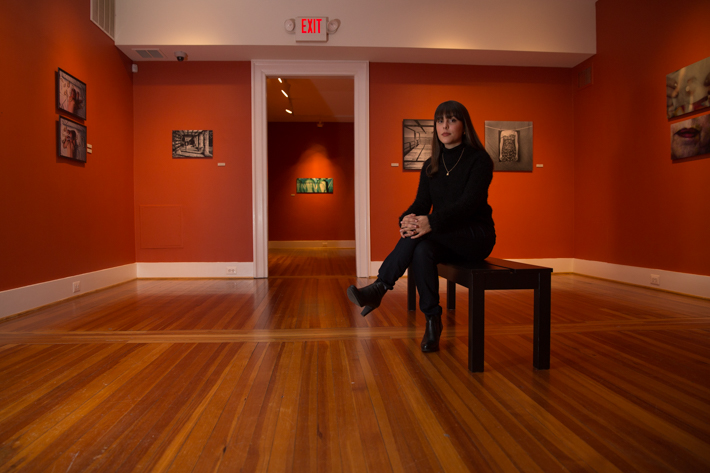In Yamina del Real’s photograph “Casa Vacía,” or “Empty House,” the Mexican artist portrays an ubiquitous scene: In an unoccupied bedroom, someone has left her laptop alone on a rumpled bed. The room is bare, lit only by sunrays pouring in through a nearby window. To Mariana Rivera, a junior in the Corcoran School of the Arts and Design, the image’s quiet desolation communicates a sense of solitude generated by the digital age.
“To me, it’s very realistic,” she said, noting how common the picture is in her generation. “Who doesn’t go to sleep with their computer in their bed? You wake up and the first thing you check is your laptop.”
The photograph hints at a dichotomy Ms. Rivera observes when it comes to the cyber universe. The Internet unites people through billions of entwined networks, but in an era when your Mac is your first priority in the morning, have virtual connections weakened person-to-person interaction and sociability?
Ms. Rivera asked herself that question while curating the Mexican Cultural Institute’s “Contemporary Identities/Invisible Gestures” exhibition, presented in collaboration with the Iberoamerican Cultural Attachés Association (AACIA) and in conjunction with Fotoweek D.C. Through images shot by artists from all over Latin America, Spain and Portugal, the show examines how the digital world has affected social identity in Iberoamerican society. The exhibition will run through Jan. 31, 2015.
“We become somewhat anonymous in cyberspace, where you can pick and choose what kind of identity you want to portray,” Ms. Rivera said. “But our gestures, our voices, how we act—that’s how we find our own individuality.”
Ms. Rivera heard from Muriel Hasbun, a professor and program head of photography at the Corcoran School, that the Mexican Cultural Institute was looking for a curator for the exhibition. Although Ms. Rivera was only a sophomore at the time and had never curated a professional show on her own, she applied. She secured an interview, where she teemed with confidence and conviction.
“I told them that I might not have the biggest array of experience, but what I could give is my background, my passion, my commitment and a young person’s view of what contemporary photography means,” she said.
Interested in her perspective, the Mexican Cultural Institute chose Ms. Rivera over candidates with master’s degrees. They asked her to think of a theme that would encompass all of Iberoamerica and represent artists from each country.
Ms. Rivera knew from the beginning that despite Latin American issues percolating in the news (gang violence, migration patterns, poverty), she wanted to explore each country through a broad, universal lens. She picked technology as her capacious subject and began looking for photographers from Mexico, Central America, South America, Spain and Portugal that could come together to build a mosaic of Iberoamerican experiences.
As a native of eastern Mexico’s Veracruz, Ms. Rivera had some familiarity with artists and writers in the Iberoamerican region. To surface lesser-known photographers, she turned to her very theme: the Internet. Google searches returned the surrealist work of Guatemala’s Luis Chay and the conceptual pieces of Paraguay’s Ricardo Migliorisi.
Arranged in the Mexican Cultural Institute’s rust-colored halls, the final exhibition is divided into four sections. The first includes images that show how individuals isolate themselves by relying on relationships “formed through screens.” In “Invisibly Anonymous,” Ms. Rivera puts a few pictures manipulated by Photoshop on display to question how authentic personalities are when they’re created online.
“If you have Facebook,” Ms. Rivera lists as an example, “it asks things like, ‘What are your favorite movies? What’s your relationship status?’ These are set boundaries that they give you to construct your online persona around.”
The final two parts of the exhibition, “Search for Independence” and “Freed Gestures,” implore the viewer to find identity through real interaction. It isn’t a plea to abandon technology altogether. Ms. Rivera emphasizes that cyber space is part of today’s reality. She includes “Janine,” images Ms. Hasbun took while talking on Skype to her late mother, who lived in El Salvador. The pictures are visibly pixelated and intentionally blurred—they feel a little artificial compared to real physical contact, but the telecommunication software helped bring the two closer together.
“A3,” by Cuba’s Raúl Cañibano, captures a little boy just after he’s gone swimming in the ocean. He’s covered in droplets of water and has turned toward the camera. His face is drawn in a slightly surprised expression as he looks at the lens pointed at him. Ms. Rivera said the picture embodies the spirit of the exhibition—she wants the show to encourage viewers to turn away from their screens and be present in their surroundings.
“I hope it inspires people to look into themselves and that it encourages a kind of introspection,” she said.


